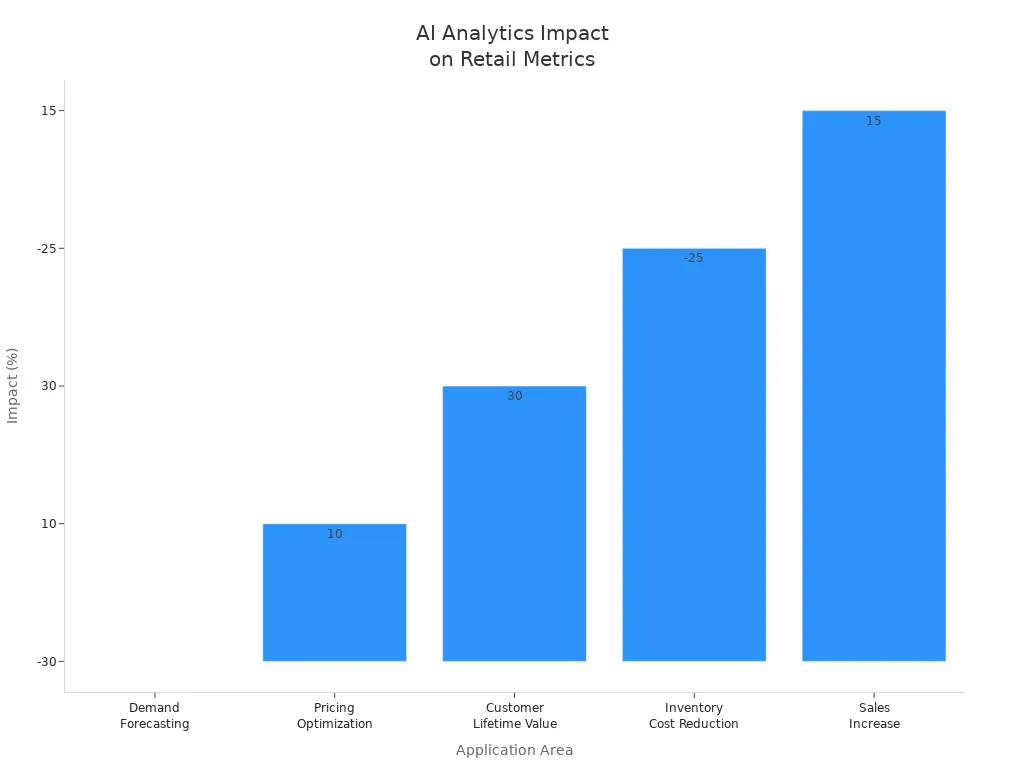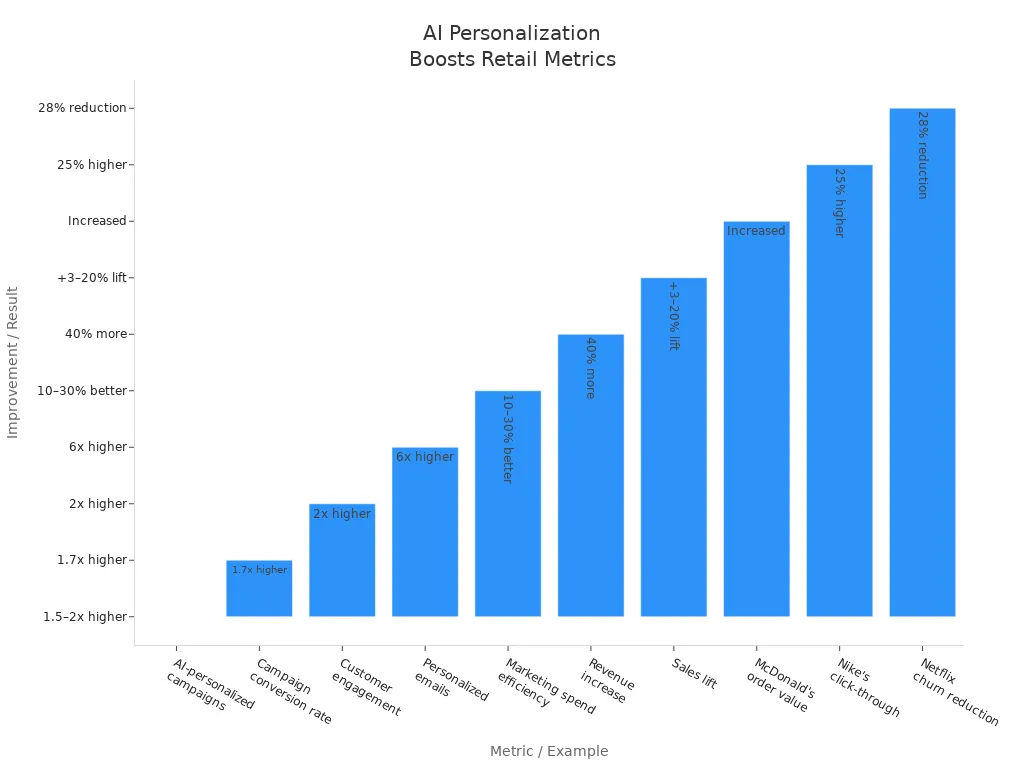AI-Driven Data Analytics Transforming Retail Marketing Strategies

AI-driven data analytics is changing retail marketing by helping companies reach customers with more personalization, better decisions, and higher ROI. Nearly 73% of organizations now use or test AI in their main operations. In retail, teams use ai-driven data analytics for recommendation engines, dynamic pricing, and demand forecasting. New trends include real-time customer segmentation and chat-driven ecommerce journeys.
Real-time insights help retailers increase sales and reduce inventory costs.
AI in retail marketing boosts customer engagement and retention through smarter data use.

Retailers see better return on investment because ai-driven data analytics uses advanced models for marketing, improving both customer satisfaction and business outcomes.
Key Takeaways
AI-driven data analytics helps retailers personalize marketing, predict customer needs, and improve sales with real-time insights.
Retailers use AI for smarter customer segmentation, personalized campaigns, and dynamic pricing to boost engagement and revenue.
AI-powered tools optimize marketing campaigns by analyzing data quickly and adjusting strategies for better results.
Protecting customer privacy and reducing bias in AI systems are essential for building trust and fairness in retail marketing.
Combining AI automation with human creativity and oversight leads to smarter decisions and stronger marketing performance.
AI-Driven Data Analytics in Retail

Core Concepts
AI-driven data analytics uses advanced technology to help retailers understand customers and improve marketing. Companies like Loblaws, ASDA, and Starbucks use these tools to personalize offers, create loyalty programs, and suggest products based on customer behavior. The table below shows how leading retailers apply core principles of ai-driven data analytics:
Retailer | AI-Driven Principle | Application in Retail Marketing |
|---|---|---|
Loblaws | Personalization at scale, breaking down data silos | AI-powered loyalty program delivers personalized offers, integrates data across 2,000+ stores |
ASDA | Gamification, value-driven personalization | Rewards app uses AI for in-app missions and targeted offers, boosting loyalty with real savings |
Starbucks | Contextual, dynamic personalization | Deep Brew AI analyzes purchase history and context to suggest offers and expand rewards |
Retailers follow several steps to use ai data analytics effectively:
Automate data collection from many channels for unified datasets.
Use machine learning for customer segmentation.
Apply predictive models to forecast trends and behaviors.
Optimize marketing campaigns in real time.
Encourage teamwork between marketing, IT, and data science.
Continuously improve AI models and strategies.
AI vs. Traditional Analytics
AI-powered analytics systems differ from traditional analytics in many ways. The table below highlights key differences:
Aspect | AI-Driven Data Analytics Systems | Traditional Analytics Methods |
|---|---|---|
Automation | Automates data processing with machine learning | Requires manual effort and expertise |
Insight Generation | Finds hidden patterns and predictive insights | Offers transparent results but may miss subtle trends |
Data Handling | Processes large, complex datasets quickly | Limited by dataset size and complexity |
Scalability | Highly scalable through automation | Struggles with big data |
Adaptability | Adapts quickly to new data and changes | Less flexible and slower to adapt |
AI-powered analytics provides real-time insights and deeper data insights, while traditional methods often miss complex patterns.
Why Retailers Use AI
Retailers adopt ai in retail marketing for many reasons:
AI-driven tools speed up decision-making with real-time insights.
AI aggregates data from many sources for better analysis.
Machine learning predicts customer demand and personalizes marketing.
AI-powered analytics supports dynamic pricing and inventory management.
AI data analytics improves customer experience with chatbots and personalized offers.
Retailers use data-driven decisions to enhance business decisions, increase revenue, and reduce costs.
AI-driven data analytics helps retailers stay competitive, adapt to market changes, and deliver advanced data analytics for better marketing results.
Applications in Marketing
Customer Segmentation
AI-driven data analytics has changed how retailers segment customers. Traditional segmentation uses static demographic data, which often misses individual preferences and behaviors. AI-driven segmentation analyzes large, dynamic datasets, including real-time customer behavior. This approach uncovers subtle patterns and micro-segments that humans might overlook. AI models adapt to changing customer behaviors, making marketing more relevant and precise.
Traditional segmentation often leads to less accurate targeting.
AI-driven segmentation finds hidden patterns and recognizes differences within similar demographic groups.
Predictive analytics in AI forecasts future customer actions, allowing proactive targeting.
AI segmentation enables more personalized campaigns, higher engagement, and better ROI.
Retailers process large datasets quickly, enabling near real-time targeted marketing.
Company | AI Application | Key Outcomes | Supporting Evidence |
|---|---|---|---|
Amazon | AI-driven recommendation engine integrated with CRM, marketing automation, and e-commerce platforms | 35% of sales from product recommendations; 20% year-over-year sales increase; personalized experience for each customer | Jeff Bezos: “If we have 10,000 customers, we have 10,000 different stores.” MarketingProfs: 25% increase in customer lifetime value, 15% boost in conversion rates |
Zara | AI to predict fashion trends and personalize customer experiences | 10% increase in sales; 5% reduction in inventory costs | Pablo Isla: “The key to our success is our ability to understand our customers and provide them with a personalized experience.” McKinsey report |
These examples show that AI-powered segmentation leads to measurable business benefits, such as increased customer lifetime value and improved conversion rates.
Personalized Marketing
AI enables retailers to deliver hyper-personalized marketing at scale. By combining generative AI and machine learning, brands create tailored customer experiences across channels. AI builds 360-degree customer profiles by analyzing structured and unstructured data, such as purchase history, browsing behavior, and social media activity. Real-time decision engines optimize marketing messages and offers for each individual.
AI-powered recommendation engines, like Amazon’s, generate a large share of revenue through personalized suggestions.
Behavior-based campaigns adapt in real time, such as sending discount emails to customers who abandon carts.
Adidas increased average order value by 259% and revenue per user by 18.5% using AI personalization.
Cross-channel personalization ensures consistent experiences across email, apps, websites, and stores, as seen with Nordstrom.
Conversational AI chatbots, like H&M’s, provide personalized styling advice, boosting engagement.
Real-time data processing allows brands like Starbucks to send location-based offers, increasing foot traffic.
80% of businesses report higher consumer spending due to personalized experiences, showing the impact of AI-driven hyper-personalization.
Metric / Example | Improvement / Result |
|---|---|
Conversion rates in AI-personalized campaigns | |
Marketing campaign conversion rate increase | 1.7× higher conversion rates |
Customer engagement rates | 2× higher engagement rates |
Personalized emails transaction rates | 6× higher than non-personalized emails |
Revenue increase from personalization efforts | 40% more revenue compared to peers |
Sales lift from personalization | +3% margin to +20% sales lift or more |
Nike's email click-through rate | 25% higher click-through rate |
Netflix churn reduction | 28% reduction in customer churn |

These results highlight how AI-driven personalized marketing improves campaign performance, engagement, and revenue.
Campaign Optimization
AI-powered analytics help retailers optimize marketing strategies and campaign performance. AI processes vast amounts of data to improve conversion rates and ad effectiveness, removing guesswork from digital marketing. Machine learning algorithms track key metrics and refine campaigns in real time.
AI measures and optimizes Customer Acquisition Cost (CAC), Return on Ad Spend (ROAS), Click-Through Rates (CTR), Customer Lifetime Value (CLV), engagement metrics, bounce rate, and conversion rates.
AI enables continuous real-time data analysis, improving accuracy and relevancy of campaign performance measurement.
Multi-touch attribution and predictive ROI forecasting allow marketers to optimize budget allocation and campaign strategies proactively.
AI dynamically manages bids, creative content, budget allocation, and audience targeting to maximize ROI and reduce waste.
Hyper-personalization at scale tailors messages, product suggestions, and incentives based on user behavior and intent.
Company | AI-Driven Solution | Key Impact |
|---|---|---|
Amazon | AI-powered product recommendation engine analyzing customer behavior and purchase history | Increased sales and average order value; enhanced customer experience; higher conversion rates |
H&M | AI-powered fashion forecasting and inventory management using deep learning and predictive analytics | Reduced unsold inventory by 21%; 30% faster trend response; 10% increase in full-price sales; operational savings |
Sephora | AI-powered Virtual Artist with facial recognition and AR for personalized beauty recommendations | Increased sales and conversion rates; improved customer experience; enhanced brand loyalty |
Euroflorist | AI-driven multivariate website optimization using Evolv AI for testing thousands of variants | 4.3% increase in conversion rates; optimized user experience |
Coca-Cola | AI-enabled content creation platform for personalized marketing materials | Increased content production; higher engagement; cost efficiency |
Retailers like Ulta Beauty and World of Wonder have also reported higher conversion rates and customer satisfaction through AI-driven campaign optimization.
Predictive Analytics
Predictive analytics powered by AI helps retailers forecast trends and understand customer behavior analysis. AI collects and processes large volumes of data from sources like social media, online reviews, and purchase history. It identifies patterns and predicts future consumer actions, allowing retailers to anticipate needs and personalize marketing campaigns.
Predictive analytics supports customer segmentation and tailored marketing strategies.
AI-powered platforms create personalized campaigns that increase effectiveness and customer loyalty.
Inventory management and demand forecasting improve by predicting product demand, reducing overstock and stockouts.
Real-time recommendations based on browsing behavior and past purchases boost sales.
Sentiment analysis helps retailers understand customer opinions and adjust marketing strategies.
AI-driven dynamic pricing adjusts prices in real time based on demand and competitor pricing.
Fraud detection improves as AI monitors transactions for suspicious activities.
Customer journey mapping helps retailers optimize the buying process and improve customer experiences.
Tool/Technology | Function | Benefit |
|---|---|---|
Artificial Intelligence | Processes large datasets to identify patterns | Enhances accuracy in predicting consumer behavior |
Machine Learning | Continuously refines predictions with new data | Improves forecast precision and adapts to market changes |
Big Data Analytics | Analyzes structured and unstructured data | Provides comprehensive insights from diverse sources |
Predictive Modeling Software | Uses historical data to predict future outcomes | Supports demand forecasting and risk management |
Demand Forecast Systems | Estimates future inventory needs using algorithms | Optimizes stock levels, reduces waste |
CRM Analytics Tools | Analyzes customer data for personalized marketing | Boosts customer engagement and loyalty |
Adidas uses predictive analytics to forecast demand by analyzing sales data, weather, and social media trends, minimizing overstock and stockouts.
Amazon employs a recommendation engine based on predictive analytics that drives 35% of its revenue through personalized suggestions.
Walmart uses AI-driven predictive models to optimize supply chains and predict regional demand spikes.
Zara tracks social media and in-store purchases to identify trends and adjust production in real time.
Starbucks uses AI called "Deep Brew" to forecast demand for seasonal drinks, optimizing inventory and reducing waste.
Nike applies Demand Sensing tools to predict sneaker trends and adjust production dynamically.
AI-driven data analytics transforms retail marketing by enabling predictive insights, campaign optimization, and hyper-personalization. Retailers who use these tools see measurable improvements in campaign performance, customer experiences, and revenue growth.
AI Data Analytics Tools

Industry Solutions
Retailers use many ai data analytics platforms to improve marketing and business performance. NetSuite’s cloud-based ERP solution stands out as a popular choice. It brings together data from inventory, supply chain, customer interactions, and financials. This platform uses ai to deliver predictive analytics, campaign personalization, and multichannel marketing optimization. Retailers like Michaels have used NetSuite to boost campaign click-through rates with generative ai.
Other leading platforms include:
Alteryx: Offers advanced machine learning for customer behavior prediction and pricing optimization.
Microsoft Power BI: Integrates with Microsoft tools and helps retailers analyze campaign performance.
Qlik: Provides strong inventory management and supply chain analytics.
Altair AI Studio: Delivers an easy interface for business users and supports large-scale data analysis.
Salesforce Marketing Cloud and Adobe Marketing Cloud: Focus on personalization engines for tailored customer experiences.
Cloud-based platforms like Altair and Alteryx scale easily and handle large data volumes. Microsoft Power BI offers simple integration, while Qlik needs more technical skill. Most platforms help retailers run large A/B tests, manage dynamic pricing, and prevent fraud. About 85% of businesses use ai-powered analytics tools, seeing faster data analysis and higher prediction accuracy.
Use Cases
Retailers see real results from ai data analytics tools. The table below shows how these tools drive better campaign performance and business outcomes:
AI Use Case | Description | Real-World Example(s) | Measurable Results/Impact |
|---|---|---|---|
Suggests products based on customer behavior and preferences | Amazon’s recommendation engine | Higher sales from personalized suggestions | |
AI Chatbots for Customer Service | Answers questions and helps customers in real time | Sephora’s Virtual Artist | Improved customer experience and engagement |
Predictive Analytics for Demand | Forecasts product demand to optimize inventory | Walmart’s demand forecasting | Fewer stockouts, better inventory management |
Supply Chain Optimization | Reduces waste and improves inventory flow | H&M’s supply chain analytics | 15% lower operational costs |
Dynamic Pricing Strategies | Changes prices in real time based on demand and competition | Multiple retailers | Maximized profit margins and competitiveness |
Retailers use ai data analytics to segment customers, predict demand, and optimize campaign performance. These tools help companies improve marketing, reduce costs, and deliver better shopping experiences.
Challenges and Oversight
Data Privacy
Retailers face serious challenges when using ai-driven data analytics. Protecting customer privacy is a top concern. Many systems collect personal data without clear consent. Some use hidden methods like browser fingerprinting and tracking cookies. These techniques gather information without the customer knowing. Biometric data, such as fingerprints or facial recognition, creates even more risk. If someone steals this data, the customer cannot change it. This increases the chance of identity theft.
Unauthorized data use and collection practices can lead to privacy violations.
Biometric data concerns make customers vulnerable to misuse.
Covert data collection techniques undermine trust and transparency.
Bias and discrimination in ai algorithms can result in unfair treatment.
Retailers must use strong strategies to protect privacy. They should focus on transparency, ethical practices, and regulatory compliance. Giving customers control over their data helps build trust.
Retailers also address security and compliance by using ai-driven management systems. These systems automate data classification and monitor transactions in real time. They help meet rules like GDPR and CCPA. Retail executives say regulatory compliance is the biggest challenge. Continuous improvement and teamwork are key to success.
Algorithmic Bias
Algorithmic bias happens when ai systems use unfair or incomplete data. This can cause problems in retail marketing. For example, product recommendations may favor one group over another. Pricing algorithms might charge different prices based on location or income. These biases can hurt customer trust and damage a brand’s reputation.
Bias can appear in product recommendations, pricing, hiring tools, and customer service bots.
Gender bias may lead to fewer discounts for women or push premium options.
Historical bias reflects past discrimination.
Sampling bias overrepresents certain groups.
Measurement bias and algorithmic bias can harm fairness.
Retailers use several strategies to reduce bias:
Employ human-in-the-loop systems to review ai outputs.
Develop feedback loops to improve ai results.
Diversify datasets and prioritize fairness.
Listen to customer concerns about bias.
Regular audits and transparency help retailers avoid legal problems and public backlash.
Human Oversight
Human oversight remains essential in ai-driven retail analytics. People interpret insights and apply context to final decisions. Retailers define clear roles for ai and humans. Ai analyzes large datasets and generates predictions. Humans use these insights to make informed choices.
Best practices include:
Set clear objectives for ai’s role in decision-making.
Prepare data-driven briefings for human decision-makers.
Align ai insights with human judgment at key milestones.
Encourage collaboration between ai and human teams.
Train staff to understand ai’s strengths and limits.
Organizations that balance ai and human judgment see better results. For example, companies using ai for supply chain optimization have increased revenue by more than 5%. Combining computational power with human creativity leads to smarter decisions.
Adopting AI in Retail Marketing
Building Skills
Retail marketing teams need new skills to use ai in retail marketing successfully. Training helps teams automate tasks like data entry, customer service, and report generation. This training also teaches teams to use ai for supply chain management and demand forecasting. Walmart improved its supply chain and reduced costs by training staff to use ai tools. Teams must learn to read data, spot patterns, and turn insights into action. They also need to understand ethical ai practices and protect customer privacy.
Ongoing training builds confidence and helps teams keep up with new ai developments. Retailers who invest in data literacy and ai skills see better campaign performance and higher customer engagement.
Skill Area | Why It Matters |
|---|---|
Data literacy | Helps teams understand and use ai insights |
AI-driven decision-making | Improves campaign timing and performance |
Ethical AI practices | Builds trust and protects customer data |
Creative content orchestration | Keeps marketing fresh and on-brand |
Integration Steps
Retailers can follow clear steps to add ai to their marketing operations without causing problems. Start by automating small, repetitive tasks like returns or loyalty program triggers. Choose ai tools that work with current systems, such as POS or CRM, and support easy connections. Train staff to monitor ai workflows and suggest improvements. Use platforms like n8n to link different retail systems and enable ai-powered marketing workflows.
Train teams on ai-driven solutions and keep them updated.
Use ai for customer segmentation to boost marketing ROI by up to 25%.
Automate personalized campaigns with ai-driven email tools for 3-5x higher engagement.
Monitor brand loyalty with ai-powered sentiment analysis.
Optimize store layouts using ai-based visual merchandising tools.
Adopt predictive analytics to forecast trends and improve campaign performance.
Use ai for dynamic pricing and real-time promotions.
Tip: Start small and scale up as teams gain confidence with ai tools.
Balancing AI and Creativity
AI handles data-heavy and repetitive tasks, but human creativity remains vital. Marketers use ai to analyze campaign performance, segment customers, and test ads. Humans add originality, emotion, and brand storytelling. When teams combine ai insights with creative ideas, they see better results. For example, companies that blend human judgment with ai recommendations achieve click-through rates 50% above the industry standard.
AI frees marketers from routine work, letting them focus on strategy and creative campaigns.
Teams should define which tasks ai handles and which need human input.
Regular feedback between ai tools and marketers keeps campaigns fresh and effective.
The best marketing teams use ai as a tool, not a replacement, for creativity.
Future success in digital marketing depends on using ai for data and automation while keeping human ingenuity at the heart of every campaign.
AI-driven data analytics transforms marketing by improving performance and boosting ROI. Retailers gain real-time visibility, dynamic product recommendations, and labor optimization. They also see better performance through faster merchandising decisions and loss prevention. To build customer-centric strategies, teams can centralize data, use AI for demand forecasting, and personalize campaigns. Marketers should balance automation with creativity and oversight to maximize ROI and campaign performance.
Real-time cross-channel visibility
Dynamic product recommendations
Labor optimization
Centralize data for unified customer views
Use AI for demand forecasting and personalization
Monitor performance and optimize marketing strategies
FAQ
What is AI-driven data analytics in retail?
AI-driven data analytics uses computer systems to study customer data. Retailers use these systems to find patterns, predict trends, and improve marketing. AI helps companies make better decisions and offer products customers want.
How does AI improve customer segmentation?
AI studies customer behavior and groups people by interests or habits. Retailers use these groups to send targeted messages. This process helps companies reach the right customers and increase sales.
Tip: AI can update customer groups quickly as shopping habits change.
Are AI-powered marketing tools safe for customer data?
Most AI tools use strong security to protect customer information. Retailers follow privacy laws and use encryption. Customers should check privacy policies before sharing personal data.
Security Feature | Purpose |
|---|---|
Encryption | Protects data |
Access controls | Limits who sees data |
Can AI replace human creativity in marketing?
AI helps with data and routine tasks. Humans create ideas and stories for campaigns. The best results come when teams use both AI and human creativity.
AI analyzes data.
People design creative messages.
Together, they build strong marketing strategies.
See Also
The Future Of Retail Lies In AI-Powered Stores
Transforming Online Store Management With AI E-Commerce Tools
What Retailers Should Understand About AI Corner Store Growth
Modern Retail Advantages Of AI Combo Vending Machines
Smart Stores Are Revolutionizing Convenience Retail Industry
